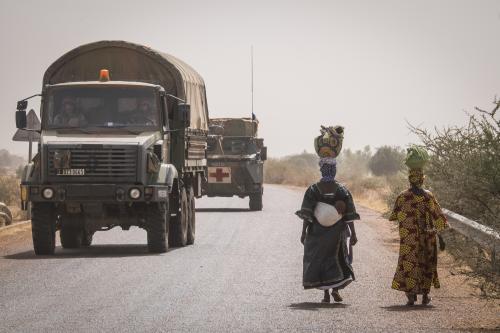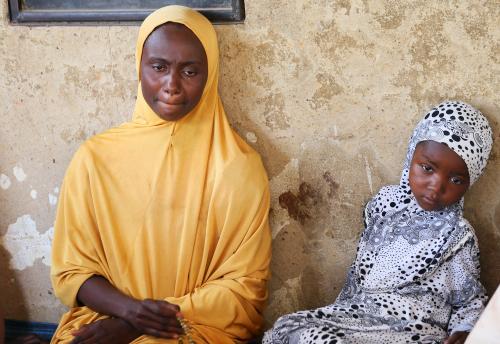With the Taliban and al Qaeda largely defeated, a temporary coalition government taking power in Afghanistan, the Freedom Bridge near Uzbekistan finally open to relief efforts, and foreign donors promising significant aid more generally, the future looks increasingly promising for the Afghan people. But many challenges remain, even beyond the immediate priority of completing the military operation. Without rapid delivery of sufficient food, shelter, and medical supplies, Afghanistan could still experience a humanitarian catastrophe this winter. Without great care to shore up the coalition government, it could fail, just as state-building efforts have failed with disastrous consequences in places such as Angola, Rwanda, and Somalia in recent years. Without sufficient delivery of reconstruction aid, Afghanistan could remain mired in the same poverty and chaos that gave rise to the Taliban in the first place.
This paper focuses on how aid and reconstruction efforts can mitigate these dangers. It focuses particularly on three issues: how many resources, and of what type, the donor community should prepare to provide to Afghanistan; how much of that aid should be distributed through the central government in Kabul and how much on a regional basis; and what type of peacekeeping force is likely to be needed in the coming weeks to help provide stability and to allow humanitarian relief efforts to occur safely and effectively.
HOW MUCH DEVELOPMENT AND RECONSTRUCTION AID IS ENOUGH?
Western leaders have promised to be generous in helping Afghanistan recover from two decades of war, recognizing that their failure to do so after Afghan mujahadeen defeated the Soviet Union in 1989 helped give rise to the very conditions that the Taliban and al Qaeda later exploited. But how much aid is needed, and what form should it take?
A good starting point for answering this question is to consider major development and reconstruction efforts of the past 60 years. The Marshall Plan for western Europe helped war-ravaged countries repair themselves quickly after World War II; it typically provided $100 to $200 per inhabitant per year over a period of several years, making for a cumulative total that often approached $1,000 per person in the end.
But that effort was designed to help advanced countries rebuild infrastructure that had only recently been in good working condition. For Afghanistan, therefore, a more analogous model may be the experiences of South Korea and Taiwan in the 1950s and early 1960s. The first had been hurt by war much worse than the second, but in both cases, the United States wanted to help key security partners build up their economies-as well as their military defenses-on short order. Aid efforts could not be quite as rapid as in Western Europe (or Japan), but in the end they were comparably generous: the United States provided roughly $50 to $75 per person per year for more than a decade, again making for an aggregate total ranging from $500 to $1,000.
The analogy with Afghanistan is hardly perfect, of course. In the cases of Taiwan and South Korea, an infrastructure had been built during the Japanese colonial era and provided some foundation for subsequent assistance efforts (though much of it was destroyed in South Korea during the war). In addition, U.S. aid was the main game in town, in contrast to the current situation in which a consortium of bilateral and multilateral donors will help Afghanistan. But for giving a rough sense of the resources required, these historical cases are still instructive.
Two final possible models from the modern era are international aid efforts for the Balkans and for the Palestinian authority. In each case, per capita aid levels have been even greater-ranging from $200 to $300 per person each year. To date, however, the development and reconstruction assistance has not produced nearly as impressive results, underscoring the basic fact that while generosity is important, more aid is not always better.
What do these numbers suggest for the case of Afghanistan? That country’s population of about 25 million, if accorded the aid levels that Taiwan and South Korea received half a century ago, would need about $1.5 billion a year for 10 to 15 years. If Afghanistan were able to absorb aid at a faster pace, the Marshall Plan experience suggests that aid levels of $3 billion a year or more might be well spent-while the Balkan and Palestinian experiences could argue for annual aid levels exceeding $5 billion.
Clearly, this is a very broad-brush analysis; much more detailed work is needed to develop a proper plan for the specific case of Afghanistan. Likewise, much more work is needed to determine how to apportion aid between the country’s various needs. Based on the above models, it might be reasonable to imagine that 20 to 25 percent of aid would be used for food and housing and medical care, 25 percent for rebuilding and developing infrastructure, 15 to 20 percent for education, 5 to 10 percent for government, 10 to 15 percent for agriculture (and the related task of clearing land mines) and 10 to 15 percent for building up security forces while helping excess militia fighters demobilize and find civilian jobs. In the case of Afghanistan, however, the latter figure for security aid might have to be larger than in many previous cases.
Whatever the specific needs turn out to be, however, donors need to be thinking in terms of an annual aid package ranging roughly from $1.5 billion to $5 billion and lasting about a decade. The lower levels may be possible if remittances from Afghans abroad prove generous and if other private funds begin to flow into the country quickly. However, such private funds often do not become easily available until a country begins to recover and begins to be a place where people can make money. Public resources tend to be the primary sources of funding for countries still mired in the early stages of development or only recently devastated by conflict.
As Carol Graham and I argued in a 1997 Brookings book, A Half Penny on the Federal Dollar: The Future of Development Aid, and as other analysts such as the World Bank’s David Dollar have demonstrated as well, aid can very easily be wasted if recipient governments do not create conducive economic and legal environments. Historically, in fact, development aid averaged across all countries has had no discernible correlation with improved economic growth. It has certainly reduced levels of child and maternal mortality, improved literacy rates, and accomplished other noble aims in most places where it has been attempted. In addition, in countries that do maintain sound economic fundamentals-low budget deficits, low inflation, realistic exchange rates, open trade and investment policies-development aid has a strong correlation with growth. (On average, when provided generously it typically increases growth rates by half a percent a year, making a real difference over a 10 to 20 year period, as the cases of countries such as Taiwan and South Korea demonstrate.) But the international donor community should not provide such large amounts of aid to Afghanistan absent reasonably promising economic policy reforms, since much of it would almost surely be wasted in that event. If Afghanistan’s new government does not adopt sound policies, aid should be kept to more modest levels and focused primarily on humanitarian relief, primary education, and some very basic infrastructural improvement rather than broader reconstruction assistance.
What are the implications for the United States? How much aid should it provide Afghanistan? Today the United States provides only about one-seventh of all global economic and development aid, despite accounting for one-fourth of global GDP. At a minimum, the United States should provide at least that one-seventh share of the Afghan development and reconstruction aid package. It may not be necessary that the United States provide a full 25 percent of the funding, since it provided most of the military forces needed to win the war. But that war has been financially inexpensive (perhaps $3 billion to $5 billion to date) relative to what will be needed to rebuild Afghanistan and keep the peace there (quite possibly $20 billion or more). In addition, to provide less than 15 percent of the total assistance would be to lose influence in how the aid effort is administered and how the country is rebuilt. Given the U.S. interest in making sure that Afghanistan becomes stable and that its people recover from a quarter-century of warfare, that would be a major mistake.
Assuming for the sake of argument a total annual aid package of $3 billion, the U.S. share might then be $400 million to $500 million. The United States could provide some of the assistance bilaterally, through the U.S. Agency for International Development and other agencies-with much of that aid actually being provided by nongovernmental organizations on the ground. The United States could also increase contributions through multilateral organizations such as UNICEF and UNDP, and continue to provide its share of funding to the World Bank and its affiliated International Development Association.
However it was provided, that amount of American aid would represent less than 5 percent of the total U.S. foreign aid budget and well under 1 percent of the overall annual costs of recovering from September 11; it would also equal less than 0.2 percent of annual U.S. defense spending. It is a small price to pay given the humanitarian and security stakes involved.
DISPERSING AID WITHIN AFGHANISTAN
Just as large levels of aid for Afghanistan must be made contingent on sound economic policies, they must also be contingent on political cooperation among Afghan factions, and must seek to foster political stability in that country. Given the country’s history, its plethora of independent power centers, and the apparent fragility of its new coalition government, these latter challenges may be the most daunting.
In practice, it is important not to provide too much aid through the central government in Kabul before that government enjoys proper legitimacy among most Afghans and before it has demonstrated a fairness in how it allocates resources. Otherwise, several problems could result. First, regional favoritism could come into play, with the regions of top leaders getting more than their fair share of dollars and technical help. Second and worse yet, the competition for spoils could lead to a lethal type of political competition in Kabul among and between different groups of resistance forces. Several groups are now in real competition in Afghanistan: Tajiks (Qanooni and Abdullah and General Fahim) and Uzbeks (notably, General Dostum of Mazar-e-Sharif) and former President Rabbani of the Northern Alliance; Pashtuns including Prime Minister Hamid Karzai and another key tribal leader, Sharzai, as well as others; and “eastern alliance” groups that fought al Qaeda in the fabled White Mountains and Tora Bora region.
One of the most important findings of modern political science is that countries moving towards democracy are highly vulnerable to conflict during their periods of intense transition. For evidence, one need only recall experiences such as Angola’s in the early 1990s, when Jonas Savimbi agreed to elections but then returned to war after losing at the ballots to President dos Santos; Rwanda in the mid-1990s when a fledgling peace process broke down and ended in genocide; and Somalia in the early 1990s when U.S. and U.N. efforts to create a new Somali government failed, after which time militia leader Aideed’s forces killed dozens of Pakistanis and Americans in ensuing battles.
What does this mean for Afghanistan? First, winner-take-all elections to create a strong central government may not be such a good idea for the foreseeable future. A relatively weak central government, representing most of the country’s main factions and ethnic groups, makes more sense. Many economic, political, and security functions should continue to be provided at the regional level. In fact, it may not even be a good idea to try to form an integrated national army anytime soon, but instead to hold out that goal for the longer term. This is in effect a Bosnia model-hardly a way to fashion a strong, unified state anytime soon, but nonetheless a practical way to move away from extremist politics while minimizing the risks of renewed warfare.
Second, and relatedly, donors should provide much of their aid and technical advice directly at the regional and grass-roots level, an argument also advanced by the International Crisis Group in its recent study on Afghanistan’s reconstruction needs (see International Crisis Group, “Afghanistan and Central Asia: Priorities for Reconstruction and Development,” November 27, 2001, available at www.crisisweb.org). Doing so should dampen the struggle for power and resources in Kabul, as leaders from various regions and ethnic groups find comfort in knowing their peoples will be aided regardless of who wields the most influence at the federal level. Providing a good deal of aid in this way would also give donors leverage with regional leaders and governments inside of Afghanistan. All would receive some aid for feeding and housing their people, clearing land mines, and rebuilding roads. But only those that avoided major corruption and massive human rights abuses, while also following sound economic practices, would receive generous aid packages for broader development and reconstruction purposes.
SURVIVING THE WINTER
So much for the medium-term agenda; what about the immediate need to help Afghans survive the winter? In a country with 5 million still considered on the verge of famine, and perhaps one million still beyond the reach of any humanitarian relief efforts, this concern remains acute.
Afghanistan remains an unsafe country in which distribution of aid supplies is impeded by chaos. Bandits are everywhere; remnants of the Taliban and al Qaeda exist in at least half a dozen parts of the country; occasional firefights break out among various opposition forces as well. Under these circumstances, being able to get aid into Afghanistan is hardly the same thing as being able to get it to those who need it most in the mountainous, Texas-sized country. The onset of winter obviously makes the situation much more difficult, and the humanitarian crisis more acute.
Unfortunately, to date both the Northern Alliance and the Bush administration have been reluctant to allow international peacekeepers into Afghanistan to rectify this situation. The recent agreement in Bonn would only provide peacekeepers for Kabul and perhaps one or two other Afghan cities, according to U.S. officials. Moreover, forces would only arrive in the course of the winter.
In opposing a more comprehensive outside peacekeeping effort, the Northern Alliance may be concerned that the presence of foreigners would lead to a dilution of their future political influence in a new government. American officials are concerned that outsiders would need to use airfields, roads, bases, and other infrastructure, possibly interfering with the still-ongoing war effort. They may also believe that Taliban and al Qaeda remnants could hide within any safe areas created by outside peacekeepers. Finally, U.S. officials may even share the concern of the Northern Alliance that the presence of British, French, German, Turk, and other outside peacekeepers would influence internal Afghani politics in undesirable ways.
Most of these objections have some kernel of reality behind them, but none should prevent the right type of immediate peacekeeping and humanitarian relief effort. Most of Afghanistan’s need is in the north, where Taliban forces have already been largely defeated and military operations have largely wound down. Peacekeepers could focus first on that area, in addition to Kabul. They could promise U.S. military forces priority access, anytime and anywhere, to any airfields or roads needed for the war effort. They could also establish strict rules for who would be allowed into camps for the internally displaced, ensuring that any Taliban or al Qaeda forces who managed to sneak in would only be able to do so without their weapons. NATO soldiers are certainly able and willing to cooperate with U.S. needs in this way; their countries are also willing to accept the casualty risks associated with such missions.
Peacekeepers would be used to defend relief convoys, provide safe areas for humanitarian relief efforts, and protect civilian populations as well as the new coalition government in Kabul. Forces numbering 10,000 to 20,000 could make a major difference for these purposes, even if they could not begin to provide regional and local security throughout all of the country. Deployments could begin quickly, especially since several major NATO allies have already earmarked forces for these purposes. Although the Pentagon claims that Northern Alliance leaders would oppose such a deployment, it is quite likely that the United States-with all the leverage it possesses with the Afghan opposition-could convince them to accept such a limited force for such a necessary task.
CONCLUSION
As they near victory in the war in Afghanistan, the United States and its partners must soon turn to winning the peace. They must ensure that that country will not again become a bastion for terrorists. The United States in particular must also prove to the Islamic world that it truly cares about the fate of Muslims and that, as President Bush rightly said when this campaign began, our fight is with the Taliban and al Qaeda, not Afghanis or Muslims more generally.
This strategy requires a number of elements. It requires the donor community to provide substantial financial and technical resources for the reconstruction of Afghanistan-quite likely $1.5 billion to $5 billion annually over the course of a decade. It requires a sophisticated plan for disbursing those resources that balances the need to support the new Kabul government with the equally pressing need to help and reassure various Afghani ethnic groups at the regional level. And not least, it demands rapidly providing humanitarian relief to the sick, cold, and starving Afghani people-not someday, not once the war is completely won, but now.
More broadly, consideration of these issues should lead the United States to reverse the cuts in its economic aid budgets of the last decade or so. The needs hardly end with Afghanistan; they also extend to Pakistan, the Central Asian former Soviet republics, poorer countries of the Middle East region, and many states in Africa as well as our own hemisphere.
The case for more aid is strong. As Carol Graham and I argued in our 1997 book, the annual U.S. assistance budget should probably increase by $4 billion to $5 billion a year, restoring it to levels of two decades ago (though still much less than a penny out of every dollar spent by the federal government). Those who believe aid does not work are half right-it often does not work well, at least in terms of sparking economic recovery and growth, when given to undeserving governments with poor economic policies. But these critics forget that aid almost always is successful in providing humanitarian relief and providing for basic human needs. They also forget that aid has been convincingly shown to contribute to development when recipient countries adopt sound economic and legal policies. If aid were reduced for countries with poor economic policies, but increased for recipients with sound economic policies and for basic human needs programs globally, an increase of the above magnitude would be very sensible.
And finally, those who argued that we can afford to tolerate the failure of remote, poor countries around the world, and turn our backs on the need to help them rebuild their nations, have been definitely proven wrong by the events of September 11. One can debate tactics, strategies, and dollar levels, but one cannot now avoid the conclusion that U.S. security is strongly linked to what happens in countries such as Afghanistan. As long as we keep our expectations realistic and strategies sound, nation building is a smart and quite often a necessary activity to undertake.
The Brookings Institution is committed to quality, independence, and impact.
We are supported by a diverse array of funders. In line with our values and policies, each Brookings publication represents the sole views of its author(s).



